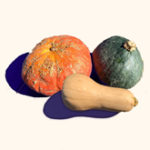winter squash
Winter squash is a deceptive name; winter squash grows in the summer, just like summer squash. But it has a tough outer rind that keeps them good through the fall and into the winter. We harvest our squash starting at the end of August and beginning of September and continue through October as each variety reaches maturity. Then we cure the squash, meaning cutting the squash from the plant and then letting it dry out for a few days in the field before bringing it in. This process heals cuts and scratches and hardens the skins (helping them resist rot and last longer) and increases the sugars (making them taste sweeter). Then we pick them up and store them in bins in the barn until we're ready to send them out to the CSA, farmers markets, or stores.
Full Belly grows as many as 15 varieties, mixing it up each year to see what tastes best. Here are some of the staple varieties: Acorn, Butternut, Delicata, Kabocha, Sweet Dumpling, Red Kuri, Spaghetti, and Tetsukabuto.
Tip for removing skin and seeds from winter squash:
- Another person shared that they’ve started using a melon baller to clean the seeds and stringy parts out the squash cavities and “it's better than anything I've ever used.”
- Or you can remove the seeds after cooking:
- Cut squash in quarters and put pieces on baking sheet in a 350º oven. Cook about 30 minutes. Transfer the squash to a cutting board. When squash is cooled it is easy to scoop out the seeds. Cut each quarter into slices and trim the outside skin. Squash is ready to cut into cubes for cooking.
- Or, if you're making puree, roast the squash whole and then remove the seeds and skin it's fully cooked.

